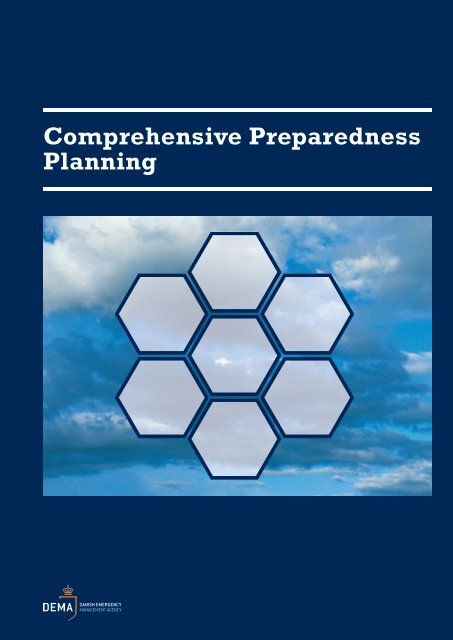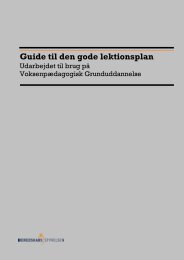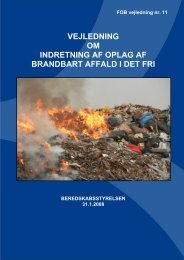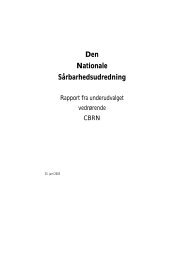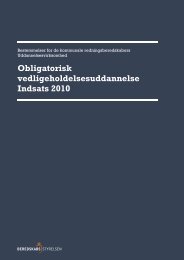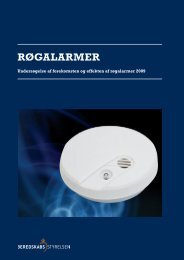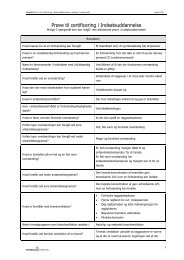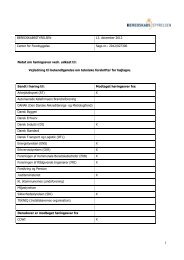Comprehensive Preparedness Planning
Comprehensive Preparedness Planning
Comprehensive Preparedness Planning
You also want an ePaper? Increase the reach of your titles
YUMPU automatically turns print PDFs into web optimized ePapers that Google loves.
<strong>Comprehensive</strong> <strong>Preparedness</strong> <strong>Planning</strong>Published by:Danish Emergency Management AgencyDatavej 16DK-3460 BirkerødTel. + 45 45 90 60 00Fax + 45 45 90 60 60E-mail: brs@brs.dkwww.brs.dkLayout: Danish Emergency Management AgencyPrint: Schultz GrafiskB 2158ISBN: 9788791590399
<strong>Comprehensive</strong> <strong>Preparedness</strong><strong>Planning</strong>Danish Emergency Management Agency 2009
2<strong>Comprehensive</strong> <strong>Preparedness</strong> <strong>Planning</strong>
Introduction1 IntroductionThe Danish Emergency Management Agency (DEMA) has developed this guide as a voluntarytool to improve the quality of existing preparedness planning or to start new planning activities.The guide is an integral part of DEMA’s webpage on comprehensive preparedness planning.Here, more inspiration, practical tools and suggestions for further reading can be found –although in Danish-language versions only. The address is www.brs.dk/hob. English-languagematerial from DEMA that readers may find useful can be found at: www.brs.dk/uk and atwww.brs.dk/fagomraade/tilsyn/csb/Eng/Civil_preparedness_division.htm.The guide – like the contents of the webpage – will be revised as the need arises. DEMA attachesimportance to dialogue in the further development of our material, and we encourageeveryone to send comments and experiences to us on: csb@brs.dk.1.1 What is comprehensive preparednessplanning?<strong>Preparedness</strong> planning is about preparing for extraordinary incidents that cannot be managedwith ordinary resources and routines alone.The purpose of the planning for each organisation is to strengthen its ability to prevent incidents,where it is possible, and to manage them, when it is necessary. In other words, preparednessplanning is about creating resilient organisations.As the logo for comprehensive preparedness planning illustrates, we divide the planning conceptinto seven general areas.The seven areas of comprehensive preparednessplanning – briefly explained:1. Programme management – which should be thecentral, pivotal point of the planning.2. <strong>Planning</strong> assumptions – analyses and ongoing activitiesthat support planning in the remaining areas.3. Prevention – measures that may prevent incidentsor reduce their probability and consequences.4. Training – for all employees who have a role in theorganisation’s emergency preparedness.5. Exercises – which all organisations in the guide’starget group should conduct and participate in.6. Evaluations – in order to utilise the learning potentialfrom incidents and exercises.7. Crisis management plans – which describe howthe organisation has prepared to respond to incidents.5
<strong>Comprehensive</strong> <strong>Preparedness</strong> <strong>Planning</strong>The notion that the organisation’s preparedness planning should be “comprehensive” does inthis connection mean that:••The organisation carries out planning activities within all seven areas.•• The planning activities are arranged according to the organisation’s needs, rather than carriedout in a particular order.••The planning covers all the critical functions that the organisation is responsible for.••The organisation’s management is actively involved in the planning.••Relevant employees throughout the whole organisation take part in the planning.••The organisation involves relevant external partners in the planning.<strong>Comprehensive</strong> preparedness planning focuses on the general build-up of capacities that canprotect organisations’ critical functions and values such as life, welfare, property, environment,reputation, etc., and is thus not limited to particular types of extraordinary incidents.The seven areas of comprehensive preparedness planning are presented below, each in itsown chapter, together with recommendations for good practice. One of the most central recommendationsis that the planning process should result in three key documents:••A preparedness policy (described in Chapter 2)••• A preparedness programme (described in Chapter 2)• A general crisis management plan (described in Chapter 8)1.2 The guide’s target group and delimitationsThe guide is addressed to all entities that play a part in society’s “collective emergency preparedness”.The target group is primarily public sector authorities and companies – regardless of whetherthey are central government departments, agencies, state-owned enterprises, regional administrations,municipalities or underlying local institutions, etc. Private companies with criticalfunctions are also welcome to use the guide – e.g. private owners and operators of criticalinfrastructure like energy supply, IT and telecommunications, hospital services, etc.As the target group is very large, the generic term “organisations” will be used throughout theguide.The guide contains suggestions for a concrete procedure for preparedness planning. It shouldbe stressed, however, that specific preparedness planning initiatives always have to be adaptedto each organisation’s needs, and to the specific legal requirements and guidelines that theparticular organisation must adhere to.6
Programme Management2 Programme ManagementIt is the management’s responsibility to ensure that theorganisation is able to perform its critical functions undernormal circumstances. These functions must also beperformed when the organisation is subject to extraordinaryincidents like e.g. serious accidents or disruptionsof critical infrastructure. Consequently, the managementmust ensure that the organisation has at its disposal arobust and flexible crisis management organisation thatcan be used when ordinary resources and routines areinsufficient.The principles for active involvement of the managementin preparedness planning do not differ from otherareas of responsibility. Also in this context, it is managers who must determine objectives, setoverall priorities, delegate tasks, allocate resources and follow up on the planning.2.1 Key management documentsIn connection with the “programme management” area of comprehensive preparedness planning,we recommend that managers and preparedness planners produce two central documents:••An overall preparedness policy•• A more detailed preparedness programmeBefore writing the two documents, it is an advantage to examine the amount and status of existingplanning, so that new efforts can be concentrated in areas, where the organisation has thebiggest needs. A questionnaire to key members of staff may be a useful tool in this respect.<strong>Preparedness</strong> policyThe aim of the preparedness policy is to determine the overall framework for the organisation’spreparedness planning. The quality of the work within the seven areas depends on clear objectivesand sound organising principles. The preparedness policy should therefore ideally be ashort document where the following aspects are adressed:••Objectives for the emergency preparedness: What does the organisation want to achievewith its emergency preparedness capacities?••Formal requirements: What laws and regulations on emergency preparedness must theorganisation adhere to?••Summary of preparedness responsibility: What are the critical functions that the organisationis responsible for maintaining? (See section 3.1.)••Overall prioritisation: Which of the seven areas should be emphasised the most?••Expectations for participation: Whom in the organisation does the management expect tocontribute actively to the ongoing development of the emergency preparedness?7
Programme ManagementGood practice for resource prioritisation in preparedness planning is to a great extent identicalto what applies to other goods and services. Among other things, the organisation mustuse transparent purchase processes, estimate costs and benefits of products and services, andchoose reliable suppliers, who live up to current quality requirements. However, the managementmust pay attention to particular conditions including:1. It is difficult to estimate the costs vis-à-vis the benefits gained from an improved ability toprevent or manage incidents. <strong>Preparedness</strong> planning is therefore similar to considerationsabout insurance, where premium payment is compared to possible losses. The organisationinvests in capacities it hopes will rarely be needed and where the real value is hard to assess.2. Only for some emergency preparedness measures (e.g. fire prevention equipment) canacquisition and operating costs be attributed exclusively to the “emergency preparednessaccount”. On the contrary, many measures serve several purposes. For example, a crisiscontrol room can also be used for meetings under normal circumstances. SCADA-systems(Supervisory Control and Data Acquisition) have both preparedness and operational rolesfor power stations, water works, and other types of critical infrastructure.3. Unexpected expenditures often occur during crises, where the organisation’s decisionmakersmust prioritise sparse resources under time pressure and without accurate information.As a general rule, it is better to establish a preparedness level that is a little too highrather than too low during a crisis. Yet, the organisation must also be able to quickly downscalethe preparedness level in order to avoid waste of resources. Normally, it is easier toadjust preparedness levels in a downward direction than in an upward direction.In connection with the organisation’s preparedness programme, it may be an advantage toprepare a specific procurement policy for emergency preparedness purposes. Such a policycan for example include guidelines for authorising staff to make extraordinarily expensive orurgent purchases during crises. If possible, high-value items of expenditure that are known inadvance might also be described directly in the organisation’s preparedness programme.2.3 Follow-upManagement must make sure that planned activities are carried out, and that results live up tothe objectives, requirements and agreements determined in the organisation’s preparednesspolicy and preparedness programme. To do this efficiently, management should consider:••Who will follow-up on the planning in general and within each individual area?••Which activities must be especially closely supervised?••How should the different forms of follow-up be carried out?The term “follow-up” must be broadly understood in this context. From a central managementlevel, routine advice and guidance will often be sufficient – perhaps combined with voluntaryself-evaluation and assurance amongst organisational units and subordinate institutions.9
<strong>Planning</strong> assumptions3 <strong>Planning</strong> assumptionsWork in the area “planning assumptions” can help theorganisation reach a sound knowledge base, which canin turn feed into the work within the other areas of comprehensivepreparedness planning.In the planning assumptions area, the organisationshould consequently acquire an overview of:••Which of the organisation’s functions are critical?••Which threats are relevant for the organisation?•• Which threats constitute the biggest risks, and whereis the organisation most vulnerable towards thethreats?3.1 Mapping of critical functionsThe purpose of mapping critical functions is to assure that the organisation has recognisedwhich activities, goods and services it must be able to maintain, even when the organisation isaffected by extraordinary incidents. The organisation must in this connection identify:••Which critical functions the organisation has operational responsibility for.••Which critical functions the organisation has overall political, legislative or administrative(sector) responsibility for.••Which resources the organisation is particularlydependent on in order to maintain its criticalfunctions with none or only minimal disruptions.Such resources may include:••Employee profiles (e.g. specific leaders andWhat constitutes a critical function fora given organisation depends on thenature and purpose of that organisation.At higher level of analysis, criticalfunctions are those activities, goods andservices that form the basis for society’sability to function. These include, amongothers, energy supply, IT and telecommunications,transportation, water andfoodstuffs, financial services, police,rescue services, health services, andsocial services.technical specialists).••Infrastructure (e.g. buildings, installations,networks, and means of transport).••Goods and services (e.g. power supply,raw materials, equipment, spare parts, ITservices, and guard duty). The organisationmust both identify dependence on the actualresources and the internal and external suppliers of the resources in question.The mapping can in practice be performed by writing lists of critical functions, key employees,infrastructure, and other critical resources. To avoid unnecessary long lists, the selection mustfocus on what is truly critical rather than what is “merely” important.11
<strong>Comprehensive</strong> <strong>Preparedness</strong> <strong>Planning</strong>3.2 Identification and monitoring of threatsAn organisation with preparedness responsibility should keep up do date with the spectrumof threats that can affect its critical functions and values like life, welfare, property, environment,reputation, etc. The identification of new threats and the monitoring of known threats is useful asa separate activity but also as input to subsequent risk and vulnerability analyses.In practice, identification and monitoring threats requires the organisation to collect reliableinformation that can illustrate:••The character and causality of individual threats.••What the comprehensive, current threat picture for the organisation looks like.••What the potential threat picture might look like in the near future or in the longer term,including:••If experiences from similar organisations nationally or abroad indicate that there arethreats, which the organisation should pay more attention to.••If the development of society in general or changes in the organisation itself mean thatnew threats become relevant, or that others become irrelevant.Identification and monitoring of threats can be integrated in the general information gatheringperformed by the organisation’s employees ona daily basis via the media, special literature,networking activities, etc. In some cases, this issupplemented by reception of specific securityintelligence and threat assessments. Theorganisation must then assure that the relevantinformation is passed on to the appropriatepersons.Certain threats will be relatively easy to identifyand monitor, because they often result inincidents, or because they for other reasonsare already subject to great attention in theorganisation. In other cases good imaginationis needed to predict new threats or new waysthat well-known threats can develop. A creativeprocess with brainstorming can help, and canfor example be systematised via workshops orinterviews with managers and key employees.Could it happen to us?Experiences from incidents elsewhere can beused in connection with the identification andmonitoring of threats. Examples from Denmark:••Industrial fires in harbour facilities in Århus(2008).••Contaminated drinking water in Køge (2007).••Evacuation of flooded residential neighbourhoodafter heavy rains in Greve (2007).••Gas explosion at racecourse in Århus (2007).••Explosion at fireworks factory in Kolding(2004).••Power outage in eastern parts of Denmarkand southern Sweden (2003).••Oil pollution at Grønsund (2001).••Leak of poisonous smoke with PVC duringfire in plastic product factory in Allerød(2000).The outcome of the identification and monitoring process can be a “threat catalogue” (i.e. alist of man-made, natural and technological threats) or a “scenario bank” (i.e. a collection ofdescriptions of potential incidents) that the organisation wants to prepare itself for. These documentscan then subsequently be used directly in risk and vulnerability analyses.12
<strong>Planning</strong> assumptions3.3 Risk and vulnerability analysesThe threat picture is complex for many organisations. In addition to this, it is neither practicallynor economically possible to mitigate all threats. The purpose of risk and vulnerability analysesis therefore to create an overview of thethreats that constitute the biggest risks, andthe vulnerabilities the organisation has inrelation to these threats.Risk and vulnerability analyses can herebyform the basis for proposing countermeasuresagainst the threats. If carried out regularly,the analyses can also enable considerationsabout preparedness to becomeintegrated in the organisation’s various otherplanning tasks.Risk and vulnerability analyses are forexample used in relation to:••Dimensioning of municipal rescue services.••Maritime port facility security assessments.••<strong>Preparedness</strong> planning within the electricityand natural gas sectors.••Compliance with IT security standards.••Financial sector reviews of operational risks.Risk and vulnerability analyses can be handled in different ways according to which specificmethod the organisation uses. We recommend that the analyses cover the following elements:1. Selection of analytical focus – e.g. continuity of the organisation’s critical functions.2. Selection of threats to be analysed – e.g. using a threat catalogue or a scenario collection.3. Assessment of the probability that the chosen threats could turn into real incidents.4. Assessment of the possible consequences, if the threats result in incidents, including:••Effects on the organisation itself and its critical functions – e.g. consequences for employees,buildings, equipment, IT, products, finances, reputation, etc.••Effects on societal values, which the organisation share responsibility for protecting – e.g.loss or damage to life, welfare, property, environment, security of the population, criticalinfrastructure, etc.5. Assessment of vulnerabilities, internally in the organisation, towards the threats that constitutethe biggest risks. The analysis can for example expose:••What measures have been implemented to prevent a particular incident.••If training and exercises empower employees with competences to handle incidents.••To which extent existing crisis management plans have prepared the organisation.••If sufficient operational capacity is at disposal for response, relief and recovery.6. Weighing the analysed threats, risks, and vulnerabilities in relation to each other. Graphicrepresentation like a risk matrix (see page 16) and a vulnerability index can be used.7. Reporting and listing proposals for potential initiatives to reduce risks and vulnerabilities.13
<strong>Comprehensive</strong> <strong>Preparedness</strong> <strong>Planning</strong>An example of a general tool is the Danish Emergency Management Agency’s model for riskand vulnerability analysis: the RVA model. It is a user-friendly electronic tool consisting of fourtemplates, which can be freely adapted to sector specific or individual organisations’ needs.The RVA model can be found at:www.brs.dk/fagomraade/tilsyn/csb/Eng/RVA/the_RVA_model.htm.14
<strong>Comprehensive</strong> <strong>Preparedness</strong> <strong>Planning</strong>consequences of incidents that do occur? Preventive measures will often work in the interestof reducing both probability and consequences.When choosing the risks that are unacceptable for the organisation, focus must primarily bedirected towards the relatively rare but potentially most serious individual incidents. More commonlyoccurring incidents must also be considered, however, if they collectively result in unacceptableconsequenceswhen added over acertain period. Manyorganisations live withrisks that they mightbe able to reducerelatively easily, butwhich they nonethelessaccept becausethe risks, when viewedseparately, are not perceivedas particularlydangerous.4.2 How can the incidents be prevented?When considering which initiatives will be most effective vis-à-vis the incidents that have beensingled out as warranting preventive efforts, these may be chosen within two general categories:••Physical measures•• Influencing behaviourPhysical measuresThis technical-oriented category of prevention serves the purpose of protecting or makingfacilities, systems, equipment, etc., more resilient. There exist a wide range of measures withvarying characteristics to choose from. Physical measures can, for instance, be:••Directed at preventing one specific type of incident (e.g. smoke detectors and fire doors) ordirected towards several types of incidents simultaneously.••Automated (e.g. standby power generators and back-up servers) or require human action.••Used in a stand-alone or combined manner. For example, protecting an installation againstunauthorised access can be achieved via physical barriers (fences, gates, locks, guards, etc.)as well as electronic security (alarm systems, surveillance cameras, etc.).Prevention by means of physical measures is often regulated by legislation, directives, technicalcodes, etc., and in certain areas it is subject to frequent control (e.g. fire inspections, health andsafety inspections, foodstuffs control). In such circumstances, each organisation may considerif it is in its own interest to adopt even more extensive preventive measures than those that aremade mandatory by authorities. In addition, there is a need for close collaboration betweenorganisational units in order to ensure a coherent prevention strategy, e.g. among local governmentdepartments which administer different laws and regulations.16
PreventionInfluencing behaviourThis type of prevention is directed at building, maintaining, or changing people’s knowledgeand attitudes – and though that – their behaviour. An important intermediate aim is to strengtheneach person’s own ability to prevent or react appropriately to undesirable incidents.The target group can be the organisation’s own employees, external partners, clients, costumersor the general population. When the target group is the organisation’s own employees,training and exercises play an especially important role (cf. chapters 5 and 6). Two other means– both internally and in relation to the surrounding society – are rules and information activities.Only authorities may issue legally binding rules for the behaviour of companies and citizens.However, all organisations can lay down rules for their own employees’ behaviour in the workplace.This may for example include an IT security policy with rules concerning the use ofpasswords, administrator rights to networks, storage and sharing of sensitive data, etc.Information activities to influence behaviour can also take many forms, including for example:••Guides, reports, strategies, educational material, etc. Sector responsible authorities can forexample issue publications to guide other organisations in fulfilling the conditions stipulatedby legislation.••Purposeful prevention campaigns, for example workshops, teaching, TV and radio features,advertisements, competitions on the internet, local community meetings and other publicarrangements.••Publishing relevant preparedness information on the organisation’s webpage and intranet.Prevention through physical measures or influencing behaviour can both be resource intensiveand measurable results are difficult to obtain in the short run. When the organisation choosesbetween alternative initiatives in the area of prevention, it must therefore compare their costswith expectations of how well the initiatives in question will work. In cases where the organisationdue to practical, economic, or other reasons cannot or will not invest in prevention, it mustrely solely on capacities for operational emergency response. An alternative option can be totransfer risks by taking out insurance against incidents, but this is by no means always possibleand, in any case, insurance policies only cover purely financial consequences.4.3 How can prevention be integratedinto other planning?The prevention area of comprehensive preparedness planning must be viewed in close connectionwith the organisation’s planning for operational emergency response, which is furtherdescribed in the guide’s Chapter 8 on Crisis Management Plans.Prevention can drastically reduce the dependence on and costs of operational response capacities.On the other hand, the necessity of operational emergency response capacities illustratesthat incidents can never be completely avoided despite preventive measures. Hence, theorganisation’s preparations to manage incidents complement its work in the area of prevention.17
<strong>Comprehensive</strong> <strong>Preparedness</strong> <strong>Planning</strong>Furthermore, many initiatives have qualities that arerelevant to both prevention and operational response,and this illustrates that there is no sharp lineseparating the two preparedness planning areas.A mobile generator can for example simultaneouslybe viewed as a preventive measure to limit theconsequences of a power outage and as a piece ofequipment to be deployed as part of the operationalresponse to a power outage.Similarly, prevention should, as far as possible, beconsidered on equal terms with quality standards,cost efficiency, etc., in the organisation’s variousother planning activities. In for example a municipality there will be numerous activities whereconsiderations about prevention are relevant. Examples include everything from the day-to-daycrime prevention collaboration between schools, social services and the police, to the currentefforts to include calculations of future climate changes into municipal zoning plans for urbanand rural areas.18
Training5 TrainingThe organisation must ensure that the people, who area part of its emergency preparedness, possess thenecessary competences to perform their emergencypreparedness tasks. This applies to all employeesregardless of their specific functions.To ensure that relevant competences are developedand maintained, the organisation’s management andpreparedness planners should systematically considerthree questions:••Which competences should the organisation haveat its disposal?••Who among the employees should be trained/improve their competences further?••How should the training/competence improvement be conducted andsustained?5.1 Which competences should the organisationhave at its disposal?The organisation should first acquire a general overview of competences it must have at itsdisposal in connection with preparedness planning and crisis management. This includes considerationsabout whether people with these competences must be employed directly in theorganisation or if the competences can be procured from external sources.The organisation might on this basis create a dedicated training programme. Such a programmecould for example include a catalogue of training activities offered to employees.As a starting point, all employees involved in the emergency preparedness should have solidknowledge of the organisation’s preparedness policy, preparedness programme and generalcrisis management plan. In this respect, special emphasis should be on employee awarenessregarding the crisis management unit and the procedures for the five core tasks of crisis management(read more in Chapter 8). Some functions in the organisations emergency preparednessmay demand that certain employees have security clearances from the authorities.For some employees it is relevant to supplement the general training with more specialisedtraining courses. For people with specific tasks during crisis, relevant course topics may forexample include:••Strategic/operational/tactical crisis management.••Staff participation.•• Use of relevant information technology for crisis management.19
<strong>Comprehensive</strong> <strong>Preparedness</strong> <strong>Planning</strong>••Crisis communication and press liaison work.•• Operational emergency response within the organisation’s preparedness responsibilityareas.Individuals who are responsible for or involved in the organisation’s more general preparednessplanning can benefit from specialised training in subject matters like:••Risk and vulnerability analysis.••Prevention.••Exercise planning.••• Evaluation of operational responses during real incidents and exercises.• Production of general crisis management plans, auxiliary plans, contingency plans, actioncards, etc.5.2 Who among the employees should be trained?Based on its identification of competence needs, the organisation must choose the employeeswho are to be offered special emergency preparedness training. The training should includeinitial training of new employees as well as maintenance and improvement of long-term employees’skills. When planning training activities, it is therefore necessary to consider staffturnover, shifts in job functions among co-workers, etc.It will usually be beneficial to offer training to the following personnel:••Operative employees – who must solve specific operational tasks during crisis, e.g. frontlineresponders in rescue services, hospitals, municipal health care, elder care, public transportcompanies, etc.••Crisis managers – who have the overall responsibility for the organisation’s crisis management.••Chiefs of staff, staff participants, and liaison officers – who are to take part in the organisation’sown crisis management unit or in multiparty crisis management staffs, e.g. at the local,regional, or national level of society’s collective emergency preparedness.••Communication specialists – who must communicate with the public and the media duringa crisis.••Employees in support functions – IT support, secretarial staff, drivers, cafeteria staff, etc.••<strong>Preparedness</strong> planners – people with responsibility for the various other areas of the organisation’scomprehensive preparedness planning.No matter which precise function an individual employee has to master, the training should, asfar as possible, build on his/her existing competences, so that the available time for training isnot misused on subject matters that he/she is already familiar with.20
Training5.3 How should the training be conductedand sustained?The training options cover a wide spectre: from short, internal introduction courses about theorganisation’s emergency preparedness to longer, qualifying education. The choice of trainingforms depends on, among other things, the requirements for employees’ competences (specifiedby external authorities or the organisation itself), ambitions, and available finances.Many courses with emergency preparedness content are on offer both within the public sectorand from specialised private companies.<strong>Preparedness</strong> relevant themes are also part of certain subjects at universities, vocational colleges,and other educational institutions. In some countries, there are complete masters degreeprogrammes devoted to emergency preparedness. Moreover, training can be conducted viadistance learning and e-learning, just as the organisation can improve competence levels byrecommending literature to its employees.Training of course also results from employees’ participation in various coordination forums,conferences, seminars, workshops, etc.Finally, a large part of the training should take place on the job (“learning-by-doing”). By givingemployees new tasks – or letting them perform existing tasks in innovative new ways – the organisationhelps to ensure that new knowledge and new skills are developed. The organisationmay for example increase the number of employees with preparedness relevant competencesby involving more people in the work to keep crisis management plans up-to-date; by lettingless experienced staff participate in exercises; or by encouraging “apprenticeships” amongveteran and novice co-workers who must be able to replace each other at short notice in caseof an incident.21
<strong>Comprehensive</strong> <strong>Preparedness</strong> <strong>Planning</strong>6 ExercisesThe organisation should exercise regularly and in adiversified manner as preparation for managing extraordinaryincidents. The purpose is to test and helpdevelop the organisation’s:••Employees•••• Plans and procedures• Equipment and technology• Cooperation with external partnersThis best way to achieve this is for the organisation toarrange its own internal exercises as well as participatein multi-party exercises arranged by others, with focuson cooperation during crises.Keeping the above purpose in mind, the organisation should primarily consider the followingthree questions when planning its exercise activities:••What should the organization exercise?••Who should participate in exercises?•• How should the organisation conduct exercises?6.1 What should the organisation exercise?The content of the exercises should be arranged in a manner that relates to the organisation’semergency preparedness responsibilities, its objectives, and the particular threat picture that itfaces. Typically, an exercise will concentrate on the organisation’s handling of a specific type ofincident, as described in an exercise scenario. Alternatively, an exercise may – independent ofincident type – be designed to train employees’ competences in relation to one or more of thefive core crisis management tasks (cf. Chapter 8).What each organisation should exercise depends on its needs for development. Exercises canbe used to reveal what works well, and should therefore be maintained, and what does not workwell, and thus should be changed. In addition, exercises can be used to improve the emergencypreparedness through testing of new techniques, procedures, etc. in a controlled environment.If the organisation only trains the functions it already knows it performs well, exercises risk becomingshowcases, with limited benefits in the form of training or new knowledge.Exercises are carried out in a controlled environment, but as a main rule they should be asrealistic as possible. Realism can for example be enhanced by basing the exercises on previouslyexperienced incidents or incidents, which the organisation fear could take place in theforeseeable future. Moreover, there must be consistency between those plans, etc., that areused during the exercises, and those that are used during real incidents.22
Exercises6.2 Who should participate in exercises?As a starting point, exercises must involve organisational units and individuals who carry outcrisis management and operational response during real incidents. However, the group ofpotential participants will vary – depending on the content of a specific exercise, and onwhether it is purely an in-house exercise or a joint exercise with other organisations. The participantscan for example be members of the organisations crisis management unit or liaisonofficers; employees from communication departments, IT-departments, and other support positions;or selected groups of staff in decentralised units with operational tasks.To make sure that the right people participate in a specific exercise, particular attention shouldbe paid to the employee turnover that has occurred since the last, similar exercise. Moreover,participation in exercises should, as far as possible, be coordinated with the wider training ofstaff with a role in the organisation’s emergency preparedness (see Chapter 5 on Training).6.3 How should the organisation conductexercises?Depending on objectives, ambitions, and available resources, the organisation can choosebetween different forms of exercises. Here, we divide them into four overall types: Procedureexercises, dilemma exercises, crisis management exercises, and full-scale exercises. Note thatother designations exist, which are close to these, and which varies in use from organisation toorganisation.The organisation can benefit from producing a specific exercise calendar or action plan as apart of its preparedness programme (cf. Chapter 2), where the resources dedicated to one ormore of the four types of exercise are spread over a period of several years.Procedure exercisesThe purpose of procedure exercises is to test, whether one or several specific proceduresin the organisation’s emergency preparedness work as intended, or if improvements areneeded. Procedure exercises can normally be conducted without extensive prior planning orexpenses.A variant of the procedure exercise is a warning or alarm drill. In its shortest form, this can bea test to see if relevant members of the organisation’s crisis management unit can be reachedby telephone or other means. In an extended form, it can be a test to see if employees physicallyshow up where they should according to the crisis management plan. In this manner, theorganisation can make sure that its procedures are adequate; that contact information is completeand up to date; and that communication technology for alerting people is working.Another variant of the procedure exercise is the evacuation drill, where the organisation tests ifstaff and guests at a given time exit the building quickly and in an orderly fashion in the event offire, bomb threats or other serious incidents.23
<strong>Comprehensive</strong> <strong>Preparedness</strong> <strong>Planning</strong>Dilemma exercisesDilemma exercises are also called discussion exercises or table-top exercises. The organisationcan conduct this kind of exercise by gathering the appropriate participants to “roleplay” how they would handle different aspects of one or more incidents in real life. The participantscan either play themselves or they can play another role, e.g. a different staff categoryfrom within the organisation or an external partner organisation. Dilemma exercisestypically last approximately half a working day, but can also just be brief discussions of howthe crisis management unit would handle a specific task – e.g. how to prepare a combinedsituation picture or set in motion a crisis communication strategy.If the organisation has not held a dilemma exercise before, it is recommended to conductit with a timeframe that gives participants ample time to find acceptable solutions. Moreexperienced organisations can conduct dilemma exercises where more pressure is put onthe participants by introducing some of the limitations or problems that exist during realincidents. This may for example include time pressure, incomplete information, overfilledrooms, long work hours, unexpected changes in personnel, intense media attention, etc.Crisis management exercisesDuring crisis management exercises the participants must rehearse their actual roles duringcrisis in their normal work situation. Usually, the participants do not know in advanceto what extent they must take part in the exercise, and they will have to attend their normalduties at the same time. Crisis management exercises can thus, to a higher degree thandilemma exercises, test practical aspects of crisis management, even though decisions areonly made on paper – i.e. nothing happens in the field. Another significant advantage is thatparticipants get to know more thoroughly the people and organisations they must cooperatewith during real crises.In comparison with dilemma exercises, crisis management exercises require more extensiveplanning, including among other things exercise regulations, an exercises script, anexercise management cell and a team of observers. Crisis management exercises also varymore in size.Full-scale exercisesFull-scale exercises are directed towards the operational level and typically include emergencyresponse activities at a simulated accident site (e.g. putting out fires, erecting barriers,evacuating affected citizens, etc). Full-scale exercises are therefore primarily relevantfor organisations that perform operational tasks during real incidents – in addition to anygeneral crisis management tasks these organisations may perform at the central or strategiclevel.A full-scale exercise can contain all of the elements that are relevant in an operational emergencyresponse context, including raising the alarm; dispatching personnel and equipment;and coordinating the activities of several different organisations during the operational responsephase. Full-scale exercises therefore provide the most intensive training and testingof operational staff. However, it is also a type of exercise that necessitates many resourcesand extensive planning. In addition to the same elements required for a crisis manage-24
<strong>Comprehensive</strong> <strong>Preparedness</strong> <strong>Planning</strong>7 EvaluationThe organisation should always evaluate its conduct –both crisis management and operational emergencyresponse – following extraordinary incidents within itsarea of responsibility. Likewise, the organisation shouldevaluate its performance after all exercises – boththose held internally and after participating in jointexercises arranged by others.The purpose is to simultaneously uncover things thatworked well during the incident or exercise in question,and should therefore be upheld, and things thatdid not work so well, and should therefore be changedto improve future conduct.The three questions that the organisation should focus on in connection with evaluations are:••What can the organisation attain through evaluations?••How can evaluations be initiated and carried out?••How is knowledge accumulated from evaluations?7.1 What can the organisation attain throughevaluations?Evaluations of organisational conduct during extraordinary incidents and exercises can deliveruseful, experience-based input to the other areas of comprehensive preparedness planning.Through evaluations the organisation can for example search for answers to questions like:••Have the appropriate preventive measures been initiated or are there better alternatives?••• Have employees acquired the necessary competences via training, exercises, and praxis?• Do general crisis management plans, auxiliary plans, contingency plans, action cards, etc.,need adjustments?••Does equipment and technology in the emergency preparedness work as intended?••Are current standard operating procedures optimal or should they be altered?When the organisation carries outits evaluations, the focus should beon “learning” rather than merely“describing”. A high-quality evaluationdocuments the course of events(who did what, when, how, and towhat effect?). However, these descriptionsare made to identifyleaning points, not simply for theirown sake.An emergency preparedness evaluation is:A systematic examination of organisational conduct duringan incident or an exercise with a clearly formulated purpose,a targeted collection of data, a focused analysis, and anindependent assessment of the conduct according to explicitcriteria, which have been determined in advance.A short written account or oral debriefing, where the participantstalk about their experiences, can be part of an evaluationbut does not in itself constitute an evaluation.26
EvaluationIn order to assess concrete potential for improvements, evaluations must account truthfully forvulnerabilities in the organisation’s emergency preparedness. For example, if significant deviationshave been made from the organisation’s crisis management plan during an exercise, orif someone has made serious mistakes whilst responding to a real incident. In other words, theorganisation must be willing to admit weaknesses to pinpoint where its emergency preparednesscan be improved and strengthened.7.2 How can evaluations be initiated andcarried out?An evaluation should be commenced and completed shortly after the specific incident orexercise in question. This is partly because the quality of the evaluation is strengthened whenexperiences are fresh in participants’ minds; partly because decision-makers are less likely touse the conclusions and recommendations of the evaluation if too much time has passed.To reduce reaction time, the organisation can benefit from preparing a general evaluationconcept with guidelines for how the organisation intends to launch and carry out evaluations.Aspects that the organisation should consider in its general evaluation concept include:••Who should undertake the evaluations? An evaluation can be done by people, who wereperforming tasks during an incident. At other times it is preferred that the evaluation is undertakenby co-workers who were not directly involved (e.g. in order to avoid bias). Finally,it may in some cases be appropriate to use external consultants (e.g. to guarantee formalindependence, resource optimisation, or when specialist knowledge is required).••Evaluation criteria. Estimations of suitability, efficiency, etc., can be related to many differentaspects of the organisation’s conduct during an incident or an exercise. We recommendthat evaluations take as their point of departure one or more of the five core tasks of crisismanagement (cf. Chapter 8). These are: 1) Activation and operation of the crisis managementunit; 2) Management of information about the crisis; 3) Coordination of actions andresources; 4) Crisis communication; and 5) Operational response.••The evaluation process. Any evaluation must be designed according to the incident or exercisein question. Different elements of the process can be tackled in different ways.7.3 How is knowledge accumulated fromevaluations?As a distinct area of the comprehensive preparedness planning, evaluations are not only aboutstarting up one project after another. It is just as important that the organisation remembers toutilize the knowledge gained from previous evaluations. When a new evaluation is carried out,we therefore recommend revisiting existing evaluation reports, among other things to be ableto systematise experiences, conclusions, and recommendations regarding the organisation’sconduct across incidents and exercises. Similarly, the organisation can often extract valuablelearning by examining evaluation reports written by other national and international entities.27
Crisis management plans8.2 How can the crisis management plan bestructured?The way the contents of crisis management plans are structured differ from organisation toorganisation, depending on areas of responsibility, organisational culture, traditions, etc.We recommend that the organisation produces a single, general crisis management plan supplementedby a number of auxiliary plans, contingency plans, action cards, templates, etc.If this advice is followed, the crisis management plan should begin with brief descriptions of:••The plan’s purpose vis-à-vis the organisation’s emergency preparedness responsibilities.••The plan’s scope (e.g. validity in an organisational, sector-wise, or geographical sense).••The plan’s central premises as regards the organisation’s emergency preparedness.••The organisational unit responsible for keeping the plan up to date and testing it.••When the plan was last updated and tested.To meet the criteria of being action oriented and comprehensible, we advice against letting thecrisis management plan begin with a lengthy description of the organisation (e.g. detailed factson the structure and activities of a government agency, municipality, company, etc.). In depthinformation of this sort can instead be integrated in the planning assumptions (cf. Chapter 3).Following the short introduction, we recommend asimple structure for the crisis management plan withone chapter for each of the five core tasks of crisismanagement:1. Activation and operation of the crisis managementunit.2. Management of information about the crisis.3. Coordination of actions and resources.4. Crisis communication.5. Operational response.For each of these five core tasks the organisationshould supplement its general crisis managementplan with more detailed planning. This is best done by means of:••Auxiliary plans for decentralised organisational units and subordinated institutions.•••Action cards with short and precise instructions regarding specific tasks.•• Contingency plans with guidance for the operational response to specific incidents.• Templates, lists, fact sheets, and other documents that can support crisis management.29
<strong>Comprehensive</strong> <strong>Preparedness</strong> <strong>Planning</strong>The organisation’s generalcrisis management planIntroduction1. Activation and operation ofthe crisis management unit2. Information management3. Coordination4. Crisis communicationAuxiliary planSection AAuxiliary planSection BAuxiliary planSection C5. Appendix with survey ofauxiliary plans, contingencyplans for operationalresponse, action cards, etc.Contingency planPandemic influenzaAction CardsTemplatesFormsListsContingency planFloodingContingency planWater contaminationAction CardsTemplatesFormsListsTo enhance clarity, auxiliary plans, contingency plans, action cards, templates, etc. can accompanythe organisation’s general crisis management plan as appendixes. Alternatively, they cansimply be noted in a reference index at the end of the general plan, if the number of documentsis large.The general crisis management plan and the supplementary documents in the “combinedplan complex” should be made accessible to users in electronic form on the organisation’snetwork as well as in paper versions. There are advantages to both formats, and the preferredformat will vary from person to person, (e.g. easy to find a paper version on an office shelf vs.easy to search for a particular section of the plan in electronic format on a personal computer).Examples of supplementary plan documents:••Auxiliary plan for an individual municipal administration supplementing the municipality’ general crisismanagement plan.••Contingency plans for responding to a natural disaster, water contamination, power outage, work siteaccident, criminal damage, release of hazardous substances, disease outbreak, or other threats that arerelevant for the organisation in question.••Action cards with instructions for initiating warnings and alarms.••A template for the agenda to be used during meetings in the organisation’s crisis management unit.••Templates for writing and updating situation reports.••Lists with contact details for crisis management unit members.••Draft versions of press releases to be concluded during crises.••Lists generating an overview of relevant external crisis management plans, used by partner organisation.In the following sections, the content of the five core tasks of crisis management is explained.30
<strong>Comprehensive</strong> <strong>Preparedness</strong> <strong>Planning</strong>then be adjusted upwards or downwards between meetings, depending on how the crisisdevelops.The meetings of the crisis management unitThe organisation should in advance have prepared a template for the agenda to be used duringthe first and subsequent meetings in the crisis management unit. It can also be advantageousto describe how often the crisis management unit will typically meet, and with whichassignment of roles. For example, should the meetings be led by a director or an appointedchief of staff?The meeting facilities of the crisis management unitThe crisis management plan should describe where the crisis management unit intends tohold its meetings, and which physical and technical means it must have access to. For manyorganisations the crisis management room can be an ordinary meeting room that is also usedfor day-to-day activities. Other organisations choose to establish dedicated “situation centres”.The crisis management room should be of sufficient size. It should be equipped with computers,television and other IT and communication equipment, but also with more simple remedieslike whiteboards, maps and written works of reference. The technical equipment must bewell-known and reliable. Adequate IT security must be in place, and alternative ways of communicationmust have been thought through, if for example the internet connection, email, ortelephone system is disrupted. The crisis management room should also – like other importantfacilities – be equipped with a stand-by power apparatus. Pay particular attention to how muchtime the emergency power supply can be expected to last.The crisis management plan can be accompanied by instructions for maintaining the crisismanagement room and its equipment under normal circumstances, and an action card statinghow it must be prepared at short notice in the event of a crisis. Additionally, there should beaction cards for logistical matters such as rest facilities, catering, transportation, etc.It might also be relevant to designate an alternative meeting place in the crisis managementplan. A few organisations even maintain a parallel crisis management room at a different location(“second site”) in case of incidents so serious, that regular facilities cannot be used.The liaison officers of the crisis management unitProcedures for the operation of the crisis management unit must ensure that agreements arehonoured regarding liaison officers to/from external partner organisations, cross-governmentcrisis management staffs, etc., and that potential requests for ad hoc participation can be met.Procedures for relieving the crisis management unitThe crisis management plan should include a procedure for how members and support staff ofthe crisis management unit can be relieved or replaced during particularly lengthy incidents.Exhausted people are less efficient and more likely to make wrong decisions. Substitutionshould ideally always include personal briefings on priority tasks, hand-over of documents, etc.32
<strong>Comprehensive</strong> <strong>Preparedness</strong> <strong>Planning</strong>••Risk assessment – Are there indications that the situation could get worse? Do changes sincethe last version of the combined situation picture was formulated influence ongoing activitiesor create a need for new activities?••Actions – Who has done/is expected to do what, where, when, and how?••Resource use – which resources are applied where, and which resources are still available?••Crisis communication – How are the organisation’s messages communicated externally?The combined situation picture can consist of both written text and information in visual form –e.g. photos, video recordings, maps, or geographical information system (GIS) entries showingthe physical location of infrastructure, buildings, vehicles, etc.The organisation’s crisis management plan must establish who has the responsibility for producingthe combined situation picture (e.g. a particular office or certain members of the crisismanagement unit). The task is substantial and several people should be allocated to the task.The combined situation picture will be used during every meeting of the crisis managementunit and updated between the meetings. Consequently, there should be a fixed template forits structure, an instruction for contributions, and a list of recipients. These documents shouldbe prepared in advance either as part of or as supplements to the general crisis managementplan.The organisation should be able to share its own situation picture with partner organisation andjoint crisis management staffs in an attempt to reach a “common” situation picture.Given that the organisation’s combined situation picture is not necessarily only meant for internaluse, technical terms and abbreviations specific to the organisation should be avoided.Minutes from crisis management unit meetingsMinutes should be taken during all crisis management unit meetings, reflecting the agenda.Particular emphasis should be on recording all concrete action points and decisions reachedduring the meetings. Given that the minutes will function as working documents during the crisis,they must be concise and distributed quickly following each meeting. The organisation canbenefit from preparing an action card that determines who takes the minutes, who proofreadsand quality checks them, who approves them, and who they must be distributed to.Management of sensitive and classified informationInformation management during a crisis will often require balancing between the need toprotect sensitive information from unwanted disclosure and the need for swift and smoothexchange of information. As regard classified information, however, rules regarding reception,storage, and distribution must always be adhered to. Clear instructions for correct handlingof sensitive and classified documents should be evident from the general crisis managementplan.34
Crisis management plansCore task 3: Coordination of actions and resourcesCrisis management never takes place in a vacuum. There will always be a need for coordinationof actions and resources – both within the organisation and vis-à-vis external partners.As regards the internal coordination, the organisation’s crisis management plan should include:••Procedures for generating a collective overview of ongoing actions and resource allocationat the central level and in decentralised units. To this end, the organisation may for exampleuse a resource database, survey, or list to sum up personnel and equipment that are eitherdeployed, ready for immediate deployment, or form non-activated reserves. Such a resourceaccount is useful in its own right, and will at the same time contribute to the organisation’swork when formulating a combined situation picture.••Instructions for how employees and other resources can be transferred between differentunits during a crisis (e.g. via secondments). In this connection, its is important to considernot only the crisis management needs, but also the fact that the “basis organisation” – independentlyof the crisis – must uphold other critical functions at an acceptable level, whilstthe crisis management takes place (business continuity planning).••Principles for decision-making competence, including how such competence is delegatedfrom the strategic to the operational level. The people responsible for the operational responseshould, as a general rule, be authorised to allocate available resources as they seefit. They should have a mandate to make all operational decisions, as long as the crisis managementunit is kept informed. The organisation may want to adopt some guidelines for howto side-step normal decision-making procedures, if these have the potential to inhibit crisismanagement in situations that require urgent decision-making.••Procedures for authorising executives to obtain and allocate extraordinary large sums, sothat crisis managers are not forced to act on an uncertain or insufficient financial basis.As regards the external coordination of actions and resources, the organisation’s crisis managementplan should primarily consider:••Which entities the organisation will usually have to coordinate with during crises, and how toinitiate bilateral cooperation immediately from the onset of a particular crisis.••How to find out which actions other organisations are planning or have already set in motionto deal with the crisis. An overview of this improves the organisation’s chances of optimisingits own resource use, and makes it easier to evaluate if specific resources can be recalled orreallocated without weakening the collective emergency response.••How the organisation intends to handle requests from others for emergency assistance, andwhat the procedure is in case the organisation itself has to ask for outside assistance.• • Which particular joint crisis management staffs, if any, the organisation must be able to participatein, who will function as liaison officers, and what their mandate will be.35
<strong>Comprehensive</strong> <strong>Preparedness</strong> <strong>Planning</strong>Core task 4: Crisis communicationDuring a crisis, a massive and sudden pressure for information typically rises from the media,citizens, partner organisations and other stakeholders. A crisis therefore put demands on theorganisation’s communication which by far exceeds what it is used to in day-to-day operations.It can be necessary to set up a dedicated crisis communication team, that can ensure a timely,reliable, and open crisis communication through the organisation’s own and external channels.Such a team can also help lay the foundations for constructive relations with the news media.The following conditions regarding the crisis communication team should be described in theorganisation’s general crisis management plan and related documents:••Tasks – An instruction or action card outlining the team’s various tasks, such as:•••Responding to inquiries from journalists, concerned citizens, etc.••Press releases and interviews for radio, TV and internet news media.•••• Updating the organisation’s webpage with information on the crisis management.• Direct warning of affected/threatened citizens via available media and technology.• Information in foreign languages for tourists, ethnic minorities, and foreign media.• Coordination of information to the public with external partners that are also involved inresponding to the crisis in question.••Management – The head of the crisis communication team (often the head of the normalcommunication unit) must be a member of the crisis management unit. Competences vis-àvisthe person leading the crisis management unit must be described clearly.••Organisation – It should be clear if the individual members of the crisis communicationteam are expected to stay at their normal work stations, or if they should work directly fromthe crisis management room or an adjacent room.••Staff – The crisis communication team will typically be a strengthened version of the normalcommunication unit, but the group of people and the allocation of roles will not necessarilybe the same. In addition to the “usual” communication employees there can for example bea need for leaders and experts tasked with making live media statements.••Resources – A resilient webpage that can manage many simultaneous visitors is one of themost important resources for updated crisis communication. More specialised means canbe the setting up of a press centre or a call-centre with dedicated telephone lines and anadvertised e-mail address for questions and answers. In this case the organisation needsinstructions for activating and manning rooms and technical facilities, standard reply guidesfor operators that can be adapted to the particular crisis, etc.••Procedures – Additional action cards, templates, etc. can lay down procedures for:•• Activation of the crisis communication team (preferably before but otherwise immediatelyafter the first meeting of crisis management unit).36
Crisis management plans••Establishment of systematic media monitoring and media analysis – partly to contributeto the combined situation picture, partly as basis for press strategies and to ensure thatany errors in the media’s coverage of the organisation are corrected.••Agendas for internal meetings in the crisis communication team.••Involvement of the crisis communication team in the crisis management unit meetings.Press strategy and media coverage should be a fixed item on the agenda.••Permanent contact person for journalists with a fixed telephone number during the crisis(press duty officer).••Contact details for persons in charge of communication at partner organisations.••Prepared drafts for press releases, fact sheets with background information, etc.••Distribution lists for press releases and communication briefings (email).••Instructions regarding who can speak to the media on behalf of the organisation (spokesmanhierarchy), specifying who in the organisation journalists may quote directly, andwho are only allowed to provide background information to the media.••Procedure that, if necessary, dictates a centralisation of all crisis communication to ensure,that the organisation speaks with one voice only.Core task 5: Operational responseIn view of the many and very different organisations in this guide’s target group, the phrase“operational response” must be interpreted as covering a very wide spectrum of emergencyactivities. In most circumstances, however, operational response is either about deployingpersonnel and equipment in the field or performing tactical/operational crisis management, asopposed to the more “strategic” aspects of crisis management inherent in core tasks 1 - 4.When the organisation activates its generalcrisis management plan, the first four coretasks will usually be relatively similar, regardlessof the specific type of incident that hasoccurred. The operational response, on theother hand, will be different from one incidentto another.To avoid an unnecessarily long general crisismanagement plan, we recommend that onlythe most universal principles for operationalresponse are described directly in the plan.Detailed planning for operational responseshould instead appear in customized contingencyplans for different incidents. Eachcontingency plan should deal with the centralaspects of a specific operational response,including:Examples of operational responses:••Visits to elderly or otherwise vulnerablepeople by municipal care personnel in theevent of extreme weather, power cuts, etc.••Provision of clean drinking water after contaminationaccidents.••Control centres’ diversion of mass traffic afterserious accidents.••Resumption of the electricity grid followingserious disruptions.••Re-establishment of compromised IT systemsand networks.••Psychological first aid following serious accidents,violent episodes, or neglect in schools,day care centres, rest homes, etc.••Putting down animals during outbreaks ofveterinary diseases.••Containing and cleaning out hazardous substancesas a result of environmental pollution.••Tasks – Which primary and secondary tasks must be tackled as a part of the response?37
<strong>Comprehensive</strong> <strong>Preparedness</strong> <strong>Planning</strong>••Management – Who is in charge of the operational response and with which mandate?••Organisation – Which units should be involved in the operational response, and how mightthe existing organisation be adapted in order to perform a satisfactory response?••Personnel and equipment – How much personnel and equipment is needed for the operationalresponse, where and when should it be deployed, and who should do what?••Procedures – How should the tasks be carried out concretely, and how should they be coordinatedwith other organisations’ operational responses?The contingency plans can be attached to the general crisis management plan as appendixes.Alternatively – if there are many contingency plans – they can be stored separately and referredto in index form within the general crisis management plan.38
Danish EmergencyManagement AgencyDatavej 16DK-3460 Birkerødwww.brs.dk


